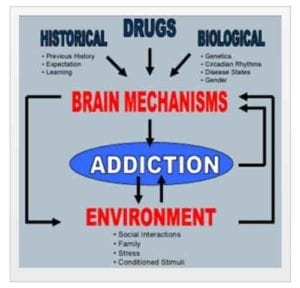THE DISEASE MODEL: IS ADDICTION CHRONIC?
Does addiction truly qualify as a chronic illness? Find out how they might be more similar than you realize.
Not everyone is convinced that addiction is chronic, meaning pervasive, lasting condition that gets worse as time goes on. For example, type II diabetes, cardiovascular disease, and cancer are examples of chronic illnesses. Do drug addiction and alcoholism truly fit in the same category as the rest of these conditions?
In order for an illness to be considered chronic, symptoms must last at least 1 year. Additionally, the person must also require regular medical attention and/or experience an impact on their daily living abilities. The National Institute on Drug Addiction backs up the understanding of addiction as a chronic and progressive illness with an extensive amount of research.

Source: The National Institute on Drug Addiction
How is addiction a chronic illness? Despite an increase in awareness surrounding the truth about addiction, some people still believe addicts can “just quit using.” This couldn’t be further from the truth for someone who truly struggles with a substance use disorder. And their chronic addiction will take them down eventually if they don’t receive the help they need.
IS ADDICTION A CHRONIC ILLNESS?
For those wondering whether addiction is chronic, it shares more similarities with other chronic illnesses. If you can’t grasp the concept of addiction to begin with, though, you won’t clearly see those similarities. Incredible amounts of misinformation still surround people with substance use disorders so developing a deeper understanding will help.
WHAT IS ADDICTION?
Addiction is a chronic and pervasive disorder characterized by compulsive drug use in the face of mounting negative consequences. Addicts continue using drugs regardless of the things that happen as a result, whether social, physical, or psychological. It’s a condition that gets worse over time without the help of some type of external intervention.

The impact of family addiction and alcoholism runs deep. Whether it is a parent, a brother, or a sister, having an addict in the family affects everyone.
While most people simply call compulsive drug use addiction, medical professionals refer to it a substance use disorder. The Diagnostic and Statistical Manual of Mental Disorders (DSM-5) outline the 11 criteria used to diagnose a person’s substance problems. They offer guidelines for what to keep an eye on when working with potential addicts.
Clinicians classify the severity of a person’s substance use disorders in one of three categories: mild, moderate or severe. The classification depends on the number of symptoms listed below that they experience in a 12-month time period:
- Mild: 2 to 3 symptoms
- Moderate: 4 to 5 symptoms
- Severe: 6 or more symptoms
SIGNS OF A SUBSTANCE USE DISORDER
- Taking more of a substance or taking it for longer periods of time than intended.
- Trying to cut down, moderate, or stop but not being able to.
- Spending a lot of time either making money to buy substances, buying substances, or using substances.
- Experiencing cravings, or a strong, overwhelming desire to use substances that often blocks out all other thoughts.
- Running into problems at home, school, or work as a direct result of substance use.
- Continuing to use substances despite the problems it causes with friends or family.
- Giving up on hobbies or activities that were once important in order to spend more time using substances.
- Ending up in risky or dangerous situations as a result of substance use.
- Using in spite of any resulting physical or psychological illnesses, or the worsening of any existing illness.
- Needing to use more of a substance in order to achieve the desired effects (also called developing a tolerance).
- Experiencing withdrawal symptoms when cutting back or quitting substance use.
THE CAUSES OF CHRONIC ADDICTION
Similar to other chronic illnesses, current research shows that a combination of genetics and environment contribute to the development of chronic drug addiction. Depending on the person, one factor might have a more significant impact than the other. Still, each of them plays a role to some extent in a person’s addiction.
When it comes to genetics researchers haven’t yet identified an “addiction gene” per se. There are specific genes that make some people more prone to experiencing negative reactions to substances. They can’t pin addiction to a single faulty gene yet, though.

In a similar manner, there isn’t one single set of environmental circumstances that cause someone to develop a substance use disorder. There are certain situations that put people at a greater risk for chronic addiction, though. For example, growing up in areas where drugs are more readily available or having another addict in the house increases a person’s chances.
ADDICTION ISN’T A CHOICE
In the same way that people with cardiovascular disease don’t choose to have the condition, people don’t choose to struggle with addiction. At first, people make a choice to start using drugs because they believe they can control it. After a certain point, though, they lose control and the power of choice over whether or not they’ll use.
It’s no longer a decision of whether or not to use, it’s a compulsive behavior that happens regardless of the consequences. Unless they seek treatment and find a solution, they have little pullover whether or not they get high. Additionally, chronic addiction is not a curable condition. There is no pill or treatment or method to cure someone of their substance use disorder.

Researchers look into the benefits of using neurofeedback as a treatment for addiction. How effective is it?
Because of this, people who have a chronic addiction problem need to treat it in a way similar to cancer patients in remission. They can’t simply quit using drugs and call it a day. Instead, they need to develop a long-term care plan such as checking in with a therapist or joining a 12-step program to keep their addiction in check.
Attending treatment at a facility like Hawaii Island Recovery is the first life-changing step to take. During the course of treatment, a case manager helps people develop their aftercare program to keep an eye on their addiction. Do you need help creating a plan to stay clean? Call us today at 877-721-3556 to find out how we can help.
